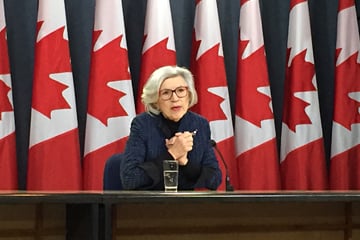
Supreme Court of Canada Chief Justice Beverley McLachlin ended her tenure in that role in the same way she began it: with a news conference.

Supreme Court of Canada Chief Justice Beverley McLachlin ended her tenure in that role in the same way she began it: with a news conference.
“When I became chief justice [in 2000], I gave a press conference,” McLachlin told reporters at the National Press Gallery in Ottawa, to introduce herself to members of the media. “Today, I’m very happy, if [for] no other reason but symmetry, to conclude my time with a press conference.”
Still officially on the bench as chief justice (Friday was her last day in the position before retirement), McLachlin spoke to reporters about the bilingualism on the bench, the judiciary and issues before it and her legacy, role models and plans for the future.
McLachlin wasn’t comfortable defining her legacy, but “I would say I’m proud of the work the court has done on indigenous files and [defining] ways in which indigenous rights can function.” Also, she said she was proud to have played “a small role” in the Charter of Rights and Freedoms.
One especially challenging matter before the Supreme Court during her tenure as a justice was the secession reference (Reference re Secession of Quebec, [1998] 2 SCR 217). “It was very challenging because it was at the edge of that fine line between Constitutional law and political matters,” McLachlin said. “We had to be careful about what we said and did, and we had the task of giving such guidance as we could that would be positive and helpful to people making decisions on Canada’s future,” she said. But it was a “wonderful experience working with the other justices of the court” on the matter, she said, “and I think [the decision] stood up very well.”
Asked about the importance of social evidence in the evolution of her decisions, McLachlin replied in French that it had, historically, always played a role, citing Edwards v. Canada (AG) — also known as the Persons Case, which in 1929 decided that women were “qualified persons” under the law and thus eligible to hold public office.
“Viscount Sankey [a sitting judge on the case] said, the law today has failed to recognize the ability of women to be senators, to hold public office; but the world has changed . . . Today, women are taking more and more place and room in society; they do hold public office. The legislation has to be changed to recognize that.”
On the rule of law and the independence of the judiciary, McLachlin noted “a decline in the continual expansion of civil liberties, the independent judiciary and the rule of law throughout the world.”
The rule of law seems to be undermined, and judges are no longer as independent as one might wish, she said. “We can hope it won’t happen in Canada. [But] we have wonderful safeguards in the Constitution (under s. 96), which creates an independent judiciary.” There is a great respect for the Charter of Rights and Freedoms and Canada and a public who values an independent judiciary, she said.
“That’s the greatest safeguard [and] the best way to preserve the rule of law and the independence of the judiciary.”
Post-retirement, McLachlin said she hoped to “push this project of access to justice forward” in the area of family law in particular and that as chief justice she took it upon herself to explain the court and justice system to the public. “In my speeches on access to justice, I have tried to . . . reassure Canadians that courts are open and we on those courts are all dedicated to provide greater justice to Canadians,” including (on the subject of bilingualism) in both official languages.
As for her role models, McLachlin said she was very fortunate to have come on the court when Brian Dickson was chief justice. “He saw beyond the letter of the law and saw what the law should be,” guiding the court very ably in the early years of interpreting the Charter, she said. Bertha Wilson, the first female judge on the court (appointed in 1982), was “an amazing jurist,” and Antonio Lamer wrote great Charter and criminal law decisions, she said.
McLachlin herself said she was most proud of her work on developing aboriginal rights and the reconciliation initiative, as well as the ongoing development or refinements to the Charter of Rights and Freedoms.
“I came on the [Supreme] Court in 1989,” she said. “We had a lot of Charter cases then and very important ones.” But many new issues have developed resulting from new technologies and their effects on privacy and more, she noted.
“Society is changing rapidly, and I expect the Supreme Court of Canada will continue to play an important role in resolving those issues.”